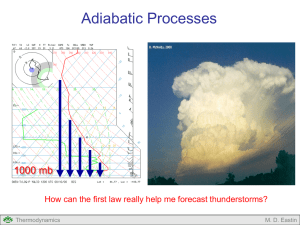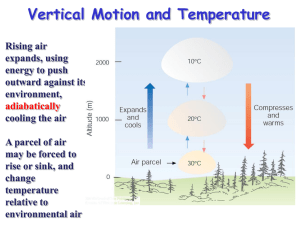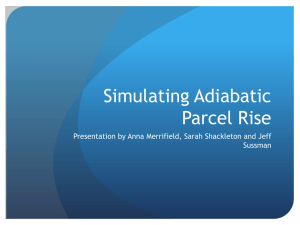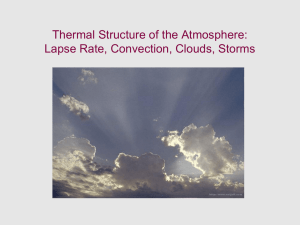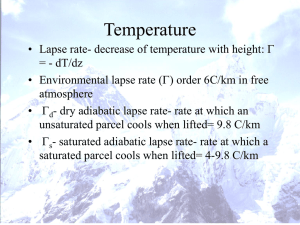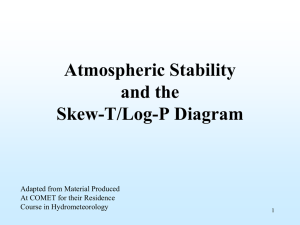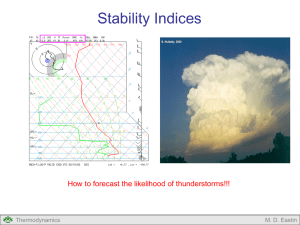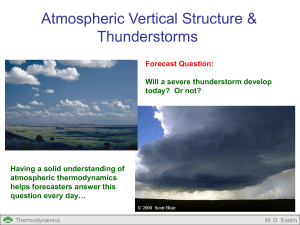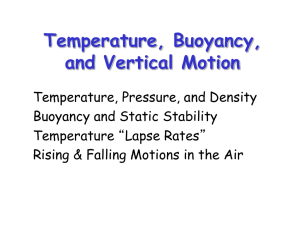Lecture #11: Parcel Buoyancy and Atmospheric Stability
advertisement
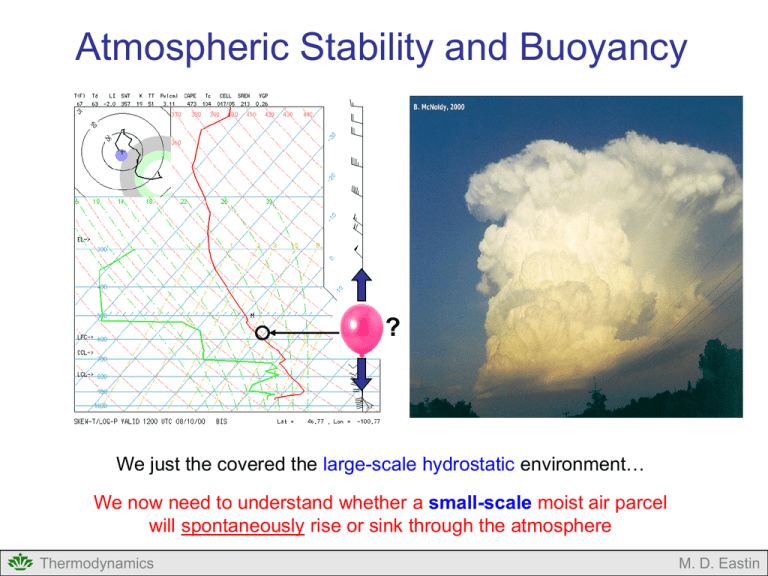
Atmospheric Stability and Buoyancy ? We just the covered the large-scale hydrostatic environment… We now need to understand whether a small-scale moist air parcel will spontaneously rise or sink through the atmosphere Thermodynamics M. D. Eastin Atmospheric Stability and Buoyancy Outline: Review Dry Adiabatic (unsaturated) Processes Moist Adiabatic (saturated) Processes Concepts Stability and Buoyancy Forced vertical motions Spontaneous vertical motions Atmospheric Stability Analysis Criteria for Unsaturated Air Criteria for Saturated Air Conditional Instability Level of Free Convection (LFC) Thermodynamics M. D. Eastin Review of Dry Adiabatic Processes Basic Idea: • No heat is added to or taken from the system which we assume to be an air parcel dq cvdT pdα 0 Parcel dq cpdT dp 0 • Changes in temperature result from either expansion or contraction • Many atmospheric processes are dry adiabatic • We shall see that dry adiabatic process play a large role in deep convective processes • Vertical motions • Thermals Thermodynamics M. D. Eastin Review of Dry Adiabatic Processes Poisson’s Relation: • Relates the initial conditions of temperature and pressure to the final temperature and pressure during a dry adiabatic process Tfinal p final Tinitial pinitial Rd cp Potential Temperature: • Special form of Poisson’s relationship • Compress all air parcels to 1000 mb • Provides a “standard” pressure level for comparison of air parcels at different altitudes Thermodynamics p0 θ T p Rd cp M. D. Eastin Review of Dry Adiabatic Processes Dry Adiabatic Ascent or Descent: • Air parcels undergoing dry adiabatic transformations maintain a constant potential temperature (θ) • During dry adiabatic ascent (expansion) the parcel’s temperature must decrease in order to preserve the parcel’s potential temperature • During dry adiabatic descent (compression) the parcel’s temperature must increase in order to preserve the parcel’s potential temperature Constant θ Thermodynamics M. D. Eastin Review of Dry Adiabatic Processes Dry Adiabatic Lapse Rate (Γd): • Describes how temperature changes with height for an air parcel moving up or down during a dry adiabatic process d dT g 9.8C / km dz cp • Potential temperature is constant • “Dry Adiabats” on the Skew-T diagram An air parcel moving between 1000-700 mb parallel to a dry adiabat Δz = 2.7 km Using Γd we should expect ΔT = 26.5ºC T700 = -12.5ºC Dry Adiabatic (Unsaturated) Thermodynamics T1000 = 14°C z700 = 2.8 km z1000 = 0.1 km M. D. Eastin Review of Moist Adiabatic Processes Saturated Ascent: • Once saturation is achieved (at the LCL), further ascent produces additional cooling (adiabatic expansion) and condensation (phase changes) occur The parcel now contains liquid water (cloud drops) The condensation process releases latent heat that warms the parcel This heat partially offsets (cancels out) the expansion cooling “Pseudo-adiabats” on Skew-T diagram Pseudo-adiabat Moist Adiabatic Ascent (Saturated) (a Cloud) TLCL Dry Adiabatic Ascent (Unsaturated) Thermodynamics Dry adiabat Td T M. D. Eastin Review of Moist Adiabatic Processes Saturated Descent: • A descending saturated air parcel that contains liquid water (cloud / rain drops) will experience warming (adiabatic compression) • The parcel will become temporarily unsaturated → cloud/rain drops evaporate The evaporation process absorbs latent heat that cools the parcel This cooling partially offsets (cancels out) the compression warming “Pseudo-adiabats” on Skew-T diagram Moist Descent (Saturated) (Cloud evaporation) Moist Descent (Saturated) (Rain evaporation) Thermodynamics Pseudo-adiabat Pseudo-adiabat M. D. Eastin Concept of Stability Basic Idea: Ability of an air parcel to return to is level of origin after a displacement Thermodynamics M. D. Eastin Concept of Stability Basic Idea: Ability of an air parcel to return to is level of origin after a displacement Depends on the temperature structure of the atmosphere Temperature Dewpoint Temperature Thermodynamics M. D. Eastin Concept of Stability Three Categories of Stability: Stable: • Returns to its original position after displacement Neutral: • Remains in new position after being displaced Unstable: • Moves further away from its original position after being displaced Thermodynamics M. D. Eastin Concept of Stability Evidence of stability type in the atmosphere: • The type of cloud depends on atmospheric stability Stratus – Stable Thermodynamics Cumulus – Unstable M. D. Eastin Concept of Stability How is air displaced? Forced Ascent • Flow over mountains • Flow over cold and warm fronts Thermodynamics M. D. Eastin Concept of Stability How is air displaced? Spontaneous Ascent • Air parcel is warmer than its environment which means the parcel is “buoyant” • Air becomes buoyant through “heating” Warm Cool Thermodynamics Hot Cool M. D. Eastin Concept of Buoyancy Basic Idea: Archimedes Principle: The buoyant force exerted by a fluid on an object in the fluid is equal in magnitude to the weight of fluid displaced by the object. Bubble in a tank of water B = Buoyancy Force Thermodynamics B M. D. Eastin Concept of Buoyancy Basic Idea: • Let’s forget the bubble for now… Tank of water •Pressure in the tank increases with depth L • Pressure is the force per unit area exerted by the weight of all the mass lying above that height • Identical to our atmosphere • Water in the tank is in hydrostatic balance dp w g dz Thermodynamics P Z H M. D. Eastin Concept of Buoyancy Basic Idea: • Water in the tank is in hydrostatic balance Tank of water • At any given point within the tank the upward directed pressure gradient force (dp/dz) must balance the downward directed gravitational force (-ρwg) imposed by the weight of the water mass above that point F F dp w g dz L -ρwg P Z dp/dz H • The water does not move up or down Thermodynamics M. D. Eastin Concept of Buoyancy Basic Idea: • Let’s return to our bubble! Bubble in a tank of water • If we examine the forces acting along the black line located at the base of the bubble: • On either side of the bubble ( ) the upward and downward directed forces balance • At the bubble base ( ), the upward directed pressure gradient force is the same, but the downward directed gravitational force is different -ρwg -ρbg -ρwg dp/dz dp/dz dp/dz • The mass of the bubble must be taken into account (-ρbg) Thermodynamics M. D. Eastin Concept of Buoyancy Basic Idea: Option #1: • If the mass of the bubble is less than the mass of the water it replaces… Bubble in a tank of water b w then the pressure gradient force will be stronger than the gravitational force… dp b g dz B -ρbg dp/dz and the bubble will experience an upward directed buoyancy force (B) • The bubble will accelerate upward! Thermodynamics M. D. Eastin Concept of Buoyancy Basic Idea: Option #2: • If the mass of the bubble is greater than the mass of the water it replaces… Bubble in a tank of water b w then the pressure gradient force will be weaker than the gravitational force… dp b g dz B -ρbg dp/dz and the bubble will experience an downward directed buoyancy force (B) • The bubble will accelerate downward! Thermodynamics M. D. Eastin Concept of Buoyancy Basic Idea: A Different View… At the moment of Archimedes’ famous discovery Thermodynamics M. D. Eastin Concept of Buoyancy Basic Idea: Applied to the Atmosphere… • Large-scale environment is in hydrostatic balance dp e g dz • If the density of a moist air parcel (ρp) is less than the density of the environmental air (ρe) that it displaces, then the air parcel will experience an upward directed buoyancy force (B): B ρe ρp ρe p e Thermodynamics M. D. Eastin Concept of Buoyancy Basic Idea: Applied to the Atmosphere… • Large-scale environment is in hydrostatic balance dp e g dz • If the density of a moist air parcel (ρp) is greater than the density of the environmental air (ρe) that it displaces, then the air parcel will experience a downward directed buoyancy force (B): B ρe ρp ρe p e Thermodynamics M. D. Eastin Concept of Buoyancy Basic Idea: Applied to the Atmosphere… • Recall from the Ideal Gas Law: p ρR d Tv Warm Air Rises! virtual temperature of an air parcel is inversely proportional to density • If the virtual temperature of a moist air parcel (Tvp) is greater than that of the nearby environmental air (Tve), then the air parcel will experience an upward directed buoyancy force (B): B Tve Tvp Tve Tp Te Thermodynamics M. D. Eastin Concept of Buoyancy Basic Idea: Applied to the Atmosphere… • Recall from the Ideal Gas Law: p ρR d Tv Cold Air Sinks! virtual temperature of an air parcel is inversely proportional to density • If the virtual temperature of a moist air parcel (Tvp) is less than that of the nearby environmental air (Tve), then the air parcel will experience a downward directed buoyancy force (B): B Tve Tve Tve Tp Te Thermodynamics M. D. Eastin Concept of Buoyancy Mathematical Definition of Buoyancy: • See your text for the full derivation Tvp Tve B g Tve Buoyancy Force (Virtual Temperature Form) • Other commonly used forms that are roughly equivalent… Temperature Form Tp Te B g Te Thermodynamics Potential Temperature Form θp θe B g θe Virtual Potential Temperature Form θ vp θ ve B g θ ve M. D. Eastin Atmospheric Stability Analysis Basic Idea: Unsaturated Air Use the observed atmospheric temperature profile to determine the stability of an unsaturated air parcel after vertical displacement Assume: Upward displacement • Compare Γd to the observed lapse rate (Γ) • Will the new parcel temperature be colder than, warmer than, or equivalent to the nearby environment? Thermodynamics Height • The air parcel will always cool at the dry adiabatic lapse rate (Γd) Γd Γ (parcel) (environment) Temperature M. D. Eastin Atmospheric Stability Analysis Stable: d Parcel becomes colder than nearby environment Downward Buoyancy Force Parcel will return to original location Height Criteria for Unsaturated Air Parcel: Γ Γd Temperature d Parcel becomes equivalent to the nearby environment No Buoyancy Force Parcel will remain at new location Height Neutral: Γ Γd Temperature d Parcel becomes warmer than nearby environment Upward Buoyancy Force Parcel will move further away from original location Height Unstable: Γd Γ Temperature Thermodynamics M. D. Eastin Atmospheric Stability Analysis Application: Unsaturated Air Compare the observed lapse rate (Γ) (temperature change with height) to the local dry adiabatic lapse rate (Γd) Temperature Neutral d Unstable d Stable d Thermodynamics M. D. Eastin Atmospheric Stability Analysis Application: Unsaturated Air Compare the observed lapse rate (Γ) (temperature change with height) to the local dry adiabatic lapse rate (Γd) G Temperature F E D C B Thermodynamics A M. D. Eastin Atmospheric Stability Analysis Basic Idea: Saturated Air Use the observed atmospheric temperature profile to determine the stability of a saturated air parcel after vertical displacement Assume: Upward displacement • The air parcel will always cool at the pseudo-adiabatic lapse rate (Γs) Γs • Compare Γs to the observed lapse rate (Γ) • Will the new parcel temperature be colder than, warmer than, or equivalent to the nearby environment? Thermodynamics Height (parcel) Γ (environment) Temperature M. D. Eastin Atmospheric Stability Analysis Stable: s Parcel becomes colder than nearby environment Downward Buoyancy Force Parcel will return to original location Height Criteria for Saturated Air Parcel: Γ Γs Temperature s Parcel becomes equivalent to the nearby environment No Buoyancy Force Parcel will remain at new location Height Neutral: Γ Γs Temperature s Parcel becomes warmer than nearby environment Upward Buoyancy Force Parcel will move further away from original location Height Unstable: Γs Γ Temperature Thermodynamics M. D. Eastin Atmospheric Stability Analysis Application: Saturated Air Compare the observed lapse rate (Γ) (temperature change with height) to the local pseudo-adiabatic lapse rate (Γs) Temperature Neutral s Unstable s Stable s Thermodynamics M. D. Eastin Atmospheric Stability Analysis Application: Saturated Air Compare the observed lapse rate (Γ) (temperature change with height) to the local pseudo-adiabatic lapse rate (Γs) G Temperature F E D C B A Thermodynamics M. D. Eastin Atmospheric Stability Analysis Combined Criteria for Moist Air (either saturated or unsaturated): Absolutely Unstable: Saturated parcel becomes warmer than nearby environment Γd Height Γ Γd Γs Unsaturated parcel becomes warmer than nearby environment Γs Γ Temperature Dry Neutral: Unsaturated parcel becomes equivalent to the nearby environment Saturated parcel becomes warmer than nearby environment Γd Height Γ Γd Γs Γs Γ Temperature Thermodynamics M. D. Eastin Atmospheric Stability Analysis Combined Criteria for Moist Air (either saturated or unsaturated): Conditionally Unstable: Saturated parcel becomes warmer than nearby environment Γ Height Γd Γ Γs Unsaturated parcel becomes colder than nearby environment Γd Γs Temperature The vertical temperature profile at most locations in our atmosphere is conditionally unstable • This is an important special case that we will return to in a little bit… Thermodynamics M. D. Eastin Atmospheric Stability Analysis Combined Criteria for Moist Air (either saturated or unsaturated): Moist Neutral: Saturated parcel becomes equivalent to the nearby environment Γ Height Γd Γ Γs Unsaturated parcel becomes colder than nearby environment Γs Γd Temperature Absolutely Stable: Saturated parcel becomes colder than nearby environment Γs Height Γ d Γs Γ Unsaturated parcel becomes colder than nearby environment Γ Γd Temperature Thermodynamics M. D. Eastin Atmospheric Stability Analysis Application: Moist Air Compare the observed lapse rate (Γ) (temperature change with height) to the local dry adiabatic lapse rate (Γd) and the pseudo-adiabatic lapse rate (Γs) E D C B A Thermodynamics M. D. Eastin Atmospheric Stability Analysis Conditional Instability: • Unsaturated air parcels experiencing a small vertical displacement will be stable and experience a downward buoyancy force However, if the unsaturated parcel can experience enough forced ascent with a large vertical displacement, the parcel may become saturated and reach an altitude at which it becomes warmer than its local environment Td T Where will a parcel starting at the surface become buoyant due to forced ascent? Lift the surface parcel Thermodynamics M. D. Eastin Atmospheric Stability Analysis Conditional Instability: • Unsaturated air parcels experiencing a small vertical displacement will stable and experience a downward buoyancy force However, if the unsaturated parcel can experience enough forced ascent with a large vertical displacement, the parcel may become saturated and reach an altitude at which it becomes warmer than its local environment Td T Altitude at which parcel first becomes warmer than the environment LCL Thermodynamics M. D. Eastin Atmospheric Stability Analysis Level of Free Convection (LFC): Definition: Altitude at which a lifted air parcel first becomes warmer than the nearby environment (acquires an upward buoyancy force) and begin to accelerate upward without additional forced ascent Td T Level of Free Convection (LFC) LCL Thermodynamics M. D. Eastin Atmospheric Stability Analysis Application: Find the Level of Free Convection (LFC) Find the LFC for the surface air parcel Thermodynamics M. D. Eastin Atmospheric Stability Analysis Application: Find the Level of Free Convection (LFC) Find the LFC for the surface air parcel Thermodynamics M. D. Eastin Atmospheric Stability and Buoyancy Summary: • Review • Dry Adiabatic (unsaturated) Processes • Moist Adiabatic (saturated) Processes • Concepts Stability and Buoyancy • Forced vertical motions • Spontaneous vertical motions • Atmospheric Stability Analysis • Criteria for Unsaturated Air • Criteria for Saturated Air • Conditional Instability • Level of Free Convection (LFC) Thermodynamics M. D. Eastin References Houze, R. A. Jr., 1993: Cloud Dynamics, Academic Press, New York, 573 pp. Markowski, P. M., and Y. Richardson, 2010: Mesoscale Meteorology in Midlatitudes, Wiley Publishing, 397 pp. Petty, G. W., 2008: A First Course in Atmospheric Thermodynamics, Sundog Publishing, 336 pp. Tsonis, A. A., 2007: An Introduction to Atmospheric Thermodynamics, Cambridge Press, 197 pp. Wallace, J. M., and P. V. Hobbs, 1977: Atmospheric Science: An Introductory Survey, Academic Press, New York, 467 pp. Thermodynamics M. D. Eastin
